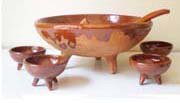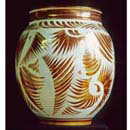ca:
RETOLACIÓ Decorativa
es:
ROTULACIÓN Decorativa
Click on the title to see more images
 Lettering is to decorate letters on to pottery; they can be formed in clay, slip and with in-glazes or on-glazes. There are different styles of letters and different methods of decorating.
Lettering is to decorate letters on to pottery; they can be formed in clay, slip and with in-glazes or on-glazes. There are different styles of letters and different methods of decorating.
This section has photos with lettering done using the Majolica method to show some of the many possibilities and styles there are. The tiles are prepared with a white, crude glaze-base and the designs have been prepared, drawn onto transparent paper, pounced and marked on with vegetable ash.
Note: The descriptions of the illustrations go from left to right.
Classical letters, without profile: the photo on the left shows a poem in Catalan, which has several words incorrectly spelt; we keep it to show clients how nice letters can be. They are painted with one color, accentuating the characteristics of the letters, which change from a thick to a thin line. Tiles 15 × 15 cm. total size 30 × 45 cm
Sala de Cata: classical letters, without profile and on the right of each one the outer line is repeated and the space it forms is covered by a light coat of the same color, this gives it a three dimensional affect. The tiles say “Room for Food.” The tiles are 15 × 20 cm and are used horizontally, it measures 15 × 120 cm. in total and the border is part of the tile.
El Asturiano: the figure is in the local dress and pouring cider, which their local custom and drink. The letters are painted in dark blue and classical but arranged to fit in to the 3 tiles vertically
Terracuita: is the name of a ceramic shop in Barcelona. The tiles 20×20cm and had to be cut to fit into the architectural setting. The name is done in the Dry-Cord method with dark blue, the tile on the right is a copy of an antique design and the word “ceràmiques” and the letter T are painted directly on to the opaque glaze-base with the color ochre.
Three designs all with very different letters: the first has strong gothic letters in dark brown, the next is Modernistic in dark blue and the last is a clients’ design, where the cat and the letters are in black and the number in ochre.
Three tiles of 20 × 20 cm: in the first and the last the letters are painted in dark brown and in the middle one the outline and the bottom part of the letters are painted in dark brown with the top part in ochre and the letters shaded on the right with an off cream color.
 Ladder A structure of wood, metal, or rope, consisting of two sidepieces with a series of bars or rungs with bars connecting both sides, at suitable distances, to climb up or down.
Ladder A structure of wood, metal, or rope, consisting of two sidepieces with a series of bars or rungs with bars connecting both sides, at suitable distances, to climb up or down. Lawn is the name of the material that is connected to the walls of a frame to form a sieve or screen. Liquids and powders are passed through the lawn for mixing and cleaning. It was originally made of silk or linen, but now it is usually metal for sieves and nylon for screens. It has a mesh, which are the tiny holes left between the woven threads. The lawns are made with different sizes of mesh, from 40 for a very coarse material, to 200 for a very fine one and they are graded by threads per inch.
Lawn is the name of the material that is connected to the walls of a frame to form a sieve or screen. Liquids and powders are passed through the lawn for mixing and cleaning. It was originally made of silk or linen, but now it is usually metal for sieves and nylon for screens. It has a mesh, which are the tiny holes left between the woven threads. The lawns are made with different sizes of mesh, from 40 for a very coarse material, to 200 for a very fine one and they are graded by threads per inch. 1) Leg is the lower part of a human body, made up of two separate sections that go from hip to the ankle.
1) Leg is the lower part of a human body, made up of two separate sections that go from hip to the ankle.  Lettering is to decorate letters on to pottery; they can be formed in clay, slip and with in-glazes or on-glazes. There are different styles of letters and different methods of decorating.
Lettering is to decorate letters on to pottery; they can be formed in clay, slip and with in-glazes or on-glazes. There are different styles of letters and different methods of decorating. 
 The drawings above illustrate the many possible shapes of lid.
The drawings above illustrate the many possible shapes of lid.

 There are 12 photos and they are to show a selection of lids, the relation between the lid and the jar and to show a few designs, there are hundreds. They are to give an idea of how important the relation between the lid and the main body is. The lid fits correctly and together they form an overall design.
There are 12 photos and they are to show a selection of lids, the relation between the lid and the jar and to show a few designs, there are hundreds. They are to give an idea of how important the relation between the lid and the main body is. The lid fits correctly and together they form an overall design.











 Lifting refers to slip or glazes lifting up off the work and is usually caused during the first hours of firing. When slip or glaze flakes off work, it could be caused by grease or dust on the fired body, by the clay being too damp or by too much difference in drying speeds between the body and the decoration when being fired. There are other words used to describe this reaction, flaking and peeling being two of them.
Lifting refers to slip or glazes lifting up off the work and is usually caused during the first hours of firing. When slip or glaze flakes off work, it could be caused by grease or dust on the fired body, by the clay being too damp or by too much difference in drying speeds between the body and the decoration when being fired. There are other words used to describe this reaction, flaking and peeling being two of them. Lines on tiles.
Lines on tiles. Painting horizontal lines. Put the tiles that are going to be decorated on a stand and use the pole to steady the movements of your hand. Hold the pole with your left hand, resting it against the small shelf that supports the tiles. With your right hand hold the brush with your thumb and first finger and with the little finger hold the pole. With your left hand move the pole smoothly to the left or right, balancing it against the small shelf so your hand holding the brush is being moved and draws the line.
Painting horizontal lines. Put the tiles that are going to be decorated on a stand and use the pole to steady the movements of your hand. Hold the pole with your left hand, resting it against the small shelf that supports the tiles. With your right hand hold the brush with your thumb and first finger and with the little finger hold the pole. With your left hand move the pole smoothly to the left or right, balancing it against the small shelf so your hand holding the brush is being moved and draws the line.


 Lip is the indented part at the edge of the neck of a jug, from where the liquid when poured, runs out. Made when clay is soft by pulling the part down and outwards with your finger, giving it the size and shape required. The center of the lip is usually designed to be directly in line with the center of the handle but it can be at 90º to it. This invisible line cuts the circle of the neck in half.
Lip is the indented part at the edge of the neck of a jug, from where the liquid when poured, runs out. Made when clay is soft by pulling the part down and outwards with your finger, giving it the size and shape required. The center of the lip is usually designed to be directly in line with the center of the handle but it can be at 90º to it. This invisible line cuts the circle of the neck in half. 
 Lip is the outer circumference of the lid that can be inside, outside or on top of the flange.
Lip is the outer circumference of the lid that can be inside, outside or on top of the flange.
 Loop tools. The photo shows four. The first is also known as a
Loop tools. The photo shows four. The first is also known as a Lustre: the word literally translated means a state or quality that reflects light, glitter, sparkle or gloss. The name is given to an on-glaze method of decorating that started in the Middle East, moved into Spain and then on to other European countries. The colors are made up from expensive metals, copper, gold, tin, silver etc and painted on to a fired glaze surface which when fired leave bright, metal colors. Superb work was made in the 15th and the 16th century in Valencia, Spain and there is a very good collection in the Victorian & Albert Museum in London.
Lustre: the word literally translated means a state or quality that reflects light, glitter, sparkle or gloss. The name is given to an on-glaze method of decorating that started in the Middle East, moved into Spain and then on to other European countries. The colors are made up from expensive metals, copper, gold, tin, silver etc and painted on to a fired glaze surface which when fired leave bright, metal colors. Superb work was made in the 15th and the 16th century in Valencia, Spain and there is a very good collection in the Victorian & Albert Museum in London. 